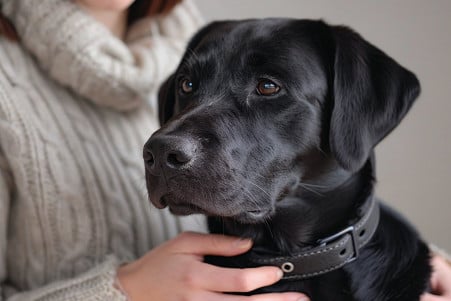How to Measure Dog Height: A Step-by-Step Guide for Pet Owners
24 February 2024 • Updated 24 February 2024

If you’re measuring your dog’s height, you’re not just going through the motions of a mundane task; you’re actually participating in an important aspect of pet care.
To measure your dog’s height, you’ll need to have your dog stand up against a wall. Then, find the withers, which is the highest point on your dog’s shoulders. After that, you’ll want to use a level to mark the height of the withers on the wall and then use a tape measure to find the distance between the floor and the line you’ve drawn.
This article will provide a detailed look at how to measure a dog, using information from veterinary science and animal care professionals. We’ll cover when to measure based on growth rates, the importance of breed standards in making sure measurements are accurate, and how accurate measurements can affect your dog’s health and well-being.
After learning about these factors, you’ll know how to measure your dog’s height properly and why it’s an important part of being a good pet owner.
How do you properly measure a dog's height?
What Are the Withers? An Important Factor in Measuring a Dog’s Height
The withers are the highest point of a dog’s shoulders and are used as the standard point for measuring a dog’s height. This is because the withers are the one point on a dog’s body that doesn’t change no matter where the dog’s head or neck is positioned.
The withers are important in terms of a dog’s anatomy because they are the highest point of the shoulders, which contributes to the dog’s topline, and they are where the neck ligaments attach to the body.
The neck ligaments are important because they are what allows a dog to move its front legs with power. The withers are located at the ridge between the shoulder blades, and this ridge is usually the highest point on a dog’s body, according to Wikipedia.
It’s important to note that the dog should be standing naturally and squarely when measuring the height of the withers. If the dog is stretching or slouching, it can change the measurement significantly.
It’s important to keep the dog relaxed to ensure that they are standing naturally and squarely, which is important for an accurate measurement. By understanding the importance of the withers in a dog’s anatomy, pet parents can feel confident in moving on to the next step of choosing the right tools to measure their dog’s height.
The Right Tools for the Job: Scales and Techniques
To measure your dog’s height accurately, you will need a sturdy tape measure, a carpenter’s level, and a yardstick.
As SPARK PAWS suggests, the tape measure should be used to measure from the ground to the withers, and the level should be used to make sure the tape measure is level so that you get consistent marks. The yardstick is used as a straight edge to go from the withers to the wall, and it helps to ensure that the level is used correctly.
In today’s world, animal scale technology has advanced to offer some new and innovative options. Smart scales that come with wireless connectivity can provide weight and height estimates, and there are even wearables that can track growth in real-time. These options are great because they are accurate and easy to use, especially for people who have larger dogs or dogs that are more cooperative.
When choosing the right tool, you should consider the size of your dog and your experience with the tools. For example, smaller, more active dogs may be fine with a tape measure and level, while people with larger dogs may want to invest in some of the height measuring tools that have been created to make the process easier.
No matter what, with the right tools and techniques, you can make sure that you are measuring your dog accurately and that you are well-equipped to keep track of their growth and health.
Know When to Measure: Growth Phases in Dogs
Understanding the growth phases that your dog goes through is important when it comes to measuring their height. This is because you need to know when these growth phases occur so that you can measure your dog at the right time. This will ensure that you get the most accurate measurements to track your dog’s growth.
Growth charts for dogs have been developed based on size categories, according to PubMed, and it’s important to note that this research emphasizes the importance of using centile lines to monitor growth in a healthy way.
As noted by PetMD, small breeds are typically done growing by 10–12 months, while larger breeds can continue to grow until they’re 18 months or even older. Meanwhile, according to Canine Journal, giant breeds can take up to three years to reach their full size.
The breed, genetics, and overall health of the dog all play a big role in how long this process takes. For instance, genetics can play a part in how quickly a puppy grows to its full size, while health problems can slow down or speed up the process.
To get the most accurate measurements, it’s important to know when your dog’s breed-specific growth phases occur and aim to measure your dog during or just after these growth phases. This will help ensure that you get the most accurate measurements, which can be used to track your dog’s growth and identify any potential health problems. Knowing when your dog’s growth phases occur can help you make more informed decisions about your dog’s health.
Breed Standards and Size Categories
One of the most important things that breed standards do is outline specific measurements for each breed, including height. Breed standards, which are set by organizations like the American Kennel Club (AKC), are meant to be a blueprint for the ideal physical characteristics of a breed.
A study published in PMC noted that breed morphometrics are highly reproducible, and most breeds are very close to their breed standards, which shows how important these standards are to maintaining the integrity of a breed.
These size categories are then set by organizations based on these breed standards, which include height as a major factor. These categories help to determine and define whether a dog is small, medium, large, or giant, and they help to show the extreme diversity in dog morphology. For example, the AKC’s breed standards include a height range for each breed, which helps to ensure that dogs meet the requirements of their size category.
While the standards are set by organizations, the specifics of how to measure a dog within those standards can vary by breed. For example, the Great Dane, which has a median withers height of 33 inches, is very different from the Chihuahua, which has a median height of 8 inches.
However, in both cases, it’s important that the dogs are measured according to breed standards and in a way that takes into account the genetic makeup of the breed to ensure the dog’s health and well-being.
In Situations Where Accuracy Is Important: Ramifications of Inaccurate Measurements
When it comes to buying a dog harness, preparing for dog shows, and keeping tabs on a dog’s health, accurate measurements are key. If you take inaccurate measurements, you may end up with a harness that doesn’t fit your dog properly, which can lead to discomfort and even injury.
As Bay Valley Vet notes, proper fit is also important for ensuring that a harness doesn’t allow a dog to escape or cause them to get hurt. In the case of dog shows, height discrepancies can lead to disqualification because dog show judges are so strict about adhering to breed standards.
One of the factors that can impact the accuracy of measurements is the dog’s body condition, which is something the Association for Pet Obesity Prevention points out. For example, an overweight dog may stand differently than a dog that’s at a healthy weight, which can impact the accuracy of the measurements.
Another factor that can impact the accuracy of measurements is the dog’s temperament. If a dog is uncooperative, they may not stand in a way that allows for accurate measurements, as Bay Valley Vet explains.
To ensure that your measurements are accurate and consistent, make sure that you’re working in a calm environment and using distractions to keep your dog relaxed as needed.
Make sure that you’re using a flexible measuring tape to ensure that you’re getting an accurate measurement and that you’re recording your measurements carefully.
Finally, make sure that you’re staying objective. As research from PMC shows, personal perception can lead to bias, which can impact the accuracy of measurements, but it’s also important for the dog’s well-being. This attention to detail will help you be a responsible pet owner and can even help you strengthen your bond with your dog.
Measuring Up: The Importance of Precise Dog Care
On the path to being a good dog owner, learning how to measure your dog accurately is one of the most important skills you can master. This article has walked you through everything you need to know, from finding the withers, the most reliable measuring point, to choosing the right tools for the job.
It has also covered how breed standards help make sure each breed stays healthy and true to its roots and when to measure your dog based on their growth.
Accurate measurements are important for everything from properly fitting harnesses to making sure your dog is comfortable and safe to making sure your dog meets breed standards, especially if you’re showing your dog. For dog owners, this knowledge can help you keep a better eye on your dog’s health and help you take better care of your dog overall.
By learning these skills, dog owners can help ensure their dogs are healthy and build stronger relationships with their pets based on understanding and care. It’s a good lesson in the importance of accuracy in pet care, where every inch matters in making sure you’re taking care of your furry friend in the best way possible.


